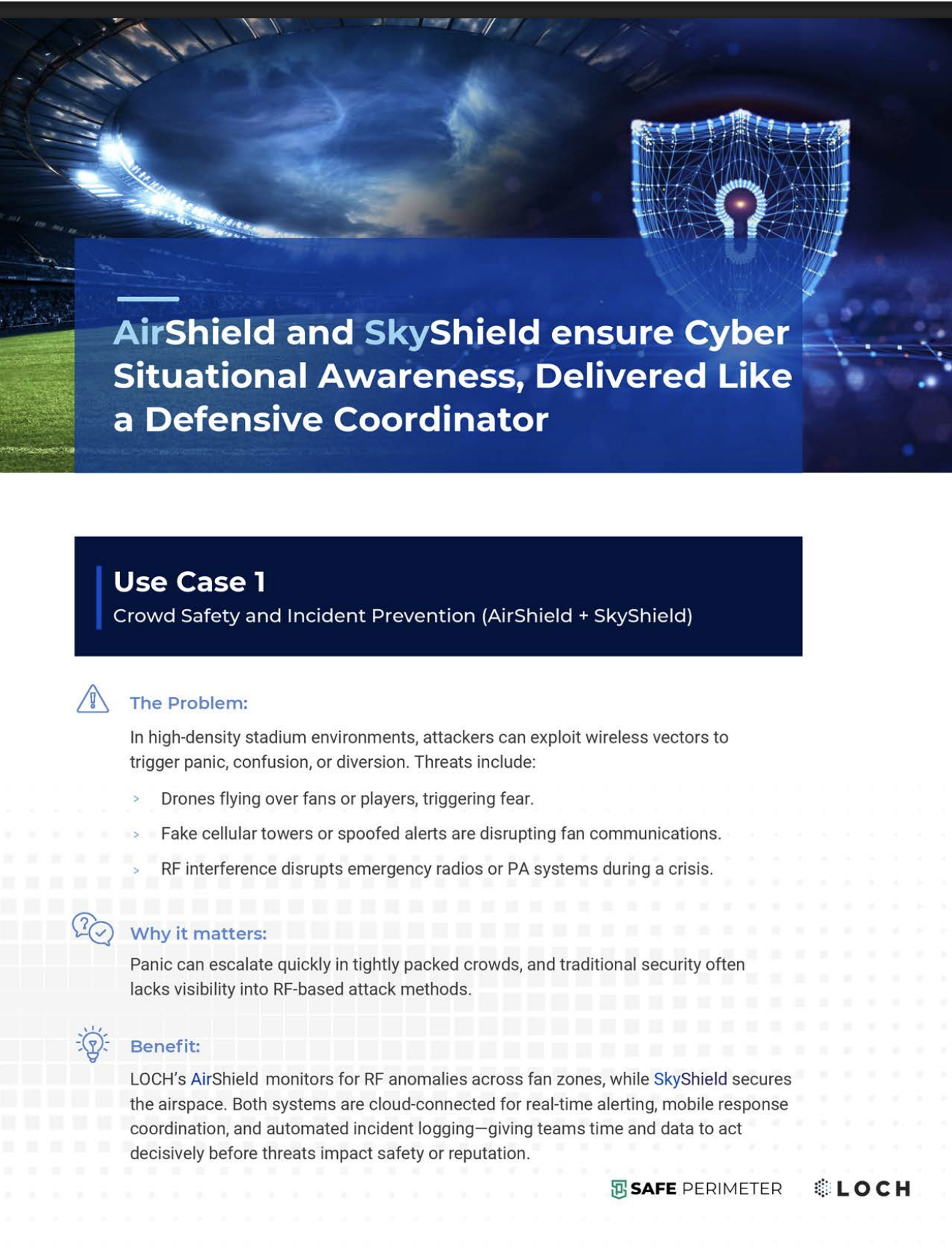SAFE Perimeter Frequently
Asked Questions
-
Safe Perimeter integrates advanced signals intelligence, cybersecurity methods, and physical security systems into a unified framework. By combining device detection, human movement patterns, CCTV, and access control technologies, we provide a complete security blueprint of people and devices in any given environment.
-
Our solutions are designed for high-value or sensitive environments such as airports, stadiums, government buildings, corporate campuses, and large-scale events. Anywhere with a need to understand who and what is present in real time benefits from our integrative approach. Safe Perimeter is designed for a wide range of public and private locations, enhancing security for the following:
Educational institutions (nonprofits, schools, universities)
Arenas, venues, and convention centers
Private properties, religious buildings, and retail malls
Transportation hubs (airports, train stations, bus depots)
Diplomatic premises, Government and federal facilities
Agricultural buildings & farms
National Special Security Events (NSSEs)
The flexibility of Safe Perimeter’s technology partners allows for both permanent and temporary installations, making it ideal for events, critical infrastructure, and high-risk areas.
-
It means we don’t rely on just one tool or technique. Instead, we build multiple, overlapping layers of defense: signals intelligence, CCTV, magnetometers, access control, and physical guards, all connected through a central intelligence platform. This layered approach dramatically reduces blind spots and increases resilience.
-
Smartphones and feature phones
Drones and vehicles
Computers and corporate beacons
Internet of Things (IoT) devices
Spy Cameras, Devices with Remote-Activated Signals
RFID-enabled items
Cellular Signals
This multi-layered detection helps create a comprehensive security shield for your facility by having authorized devices whitelisted and anomalies accounted for.
-
We apply proven cyber defense practices—such as intrusion detection, network monitoring, and device profiling—to real-world spaces. This allows us to understand the digital flow of devices alongside the physical flow of people, creating a dual-layered security posture that bridges cyber and physical domains.
-
Yes. By analyzing the flow of people and devices, our system identifies unusual behaviors—such as unauthorized devices, abnormal crowd movements, or security gaps—before they escalate. This proactive intelligence allows for intervention and prevention, not just response.
-
Because we go beyond alarms and cameras. Safe Perimeter provides a holistic, layered defense that unites cyber and physical security. Our approach delivers actionable intelligence, investigative readiness, and peace of mind, helping organizations protect people, assets, and reputations.
-
Yes, Safe Perimeter is highly customizable. You can tailor the system to meet the specific security requirements of your facility or event, adjusting settings for:
Perimeter size and coverage area
Sensitivity levels for threat detection (e.g., high-traffic areas vs. restricted zones)
Integration with your existing security equipment and protocols
Custom alerts and notification settings based on specific behaviors or devices
This flexibility makes it suitable for diverse environments, from large public venues to smaller private facilities.
-
With the proper legal authority, our platform can produce a digital fingerprint of an area—showing the devices, movements, and individuals present during an incident. This record provides investigators with a holistic reconstruction of events, improving accountability, forensic analysis, and the ability to respond effectively if something goes wrong.
-
We believe security and privacy must coexist. Our system operates within the framework of legal authority and regulatory compliance. Personal data is never shared without authorization, and our goal is to provide safety insights without unnecessary intrusion. Safe Perimeter is committed to safeguarding privacy. The system operates in strict adherence to privacy laws, utilizing data collection methods that respect individual anonymity. Key privacy measures include:
Collection of anonymized data from Wi-Fi, Bluetooth, and RFID devices, similar to standard network operations.
Systems integrated with computer vision AI follow the latest industry compliance practices for privacy.
Secure creation of threat detection lists based on lawful and ethical criteria, ensuring the focus is solely on potential risks.
-
Safe Perimeter provides comprehensive training for security personnel, ensuring they are fully equipped to operate the system efficiently.
Safe Perimeter partners offer RISK Assessments, 24/7 NOC and Managed Services, operational support, and advanced training. -
Yes, Safe Perimeter offers both temporary and permanent setup options. Temporary installations are ideal for special events or temporary security needs, such as rooftop monitoring or high-profile gatherings. For permanent systems, security perimeters can be expanded with additional hardware, allowing for flexible scaling based on the site’s requirements.
Case Studies: What makes SAFE Perimeter 360° unique?
-
Most modern crimes involve a device — a phone, drone, or wireless emitter. SAFE Perimeter turns those digital traces into investigative leads by identifying, tracking, and attributing devices present at the scene. We can help law enforcement quickly narrow suspects, link individuals to hardware, and generate case-ready intelligence for prosecution.
-
Retail operations now depend on wireless-controlled infrastructure—access control, lighting, HVAC, camera feeds, and vendor wifi systems. RF interference or compromise could cause:
Unauthorized system takeovers or disruptions.
RF jamming that disables IP security cameras.
Drone-initiated payloads targeting Wi-Fi access points or GPS receivers used in logistics.
Cyber-physical sabotage risks safety and public trust.
Benefit: AirShield detects anomalous behaviors and interference across all RF layers—including hidden IoT or OT signals—while SkyShield defends against aerial vectors targeting those systems. Together, they form a zero-trust wireless perimeter around the area, preserving operational uptime, incident traceability, and readiness for coordinated response.
-
In high-density environments, attackers can exploit wireless vectors to trigger panic, confusion, or diversion. Threats include:
Drones flying over fans or players, triggering fear.
Fake cellular towers or spoofed alerts are disrupting patron communications.
RF interference disrupts emergency radios or PA systems during a crisis.
Panic can escalate quickly in tightly packed crowds, and traditional security often lacks visibility into RF-based attack methods.
Benefit: AirShield monitors for RF anomalies across zones, while SkyShield secures the airspace. Both systems are cloud-connected for real-time alerting, mobile response coordination, and automated incident logging—giving security time and data to act decisively before threats impact safety or reputation.
-
Public Areas are flooded with personal and unauthorized RF devices—Flippers, rogue hotspots, Bluetooth skimmers, fake access points, and embedded surveillance tools to scam the public. These can be exploited for:
Credential theft via spoofed Wi-Fi portals.
Hidden RF bugs in Executive / VIP Areas, etc.
Bluetooth-based Contact tracing and Access Control manipulation.
Unmanaged devices often evade traditional security tools, creating blind spots that can compromise privacy, compliance, and safety.
Benefit: AirShield provides continuous, passive visibility across Wi-Fi, Bluetooth, Cellular (4G/5G), and more, identifying both managed and rogue devices. The system logs threat behaviors and integrates with SIEM/SOAR platforms for automated response, giving security teams actionable intel to eliminate wireless vulnerabilities without disrupting the patron experience.
-
Public Spaces are prime targets for unauthorized drones used for surveillance, livestream piracy, or even the delivery of malicious payloads. Scenarios include:
Drones hovering for espionage or media leaks.
Unauthorized aerial footage broadcast to pirate streaming platforms.
Drones dropping propaganda, pathogens, drugs, or smoke devices, or triggering panic.
Benefit: SkyShield Drone Detection provides continuous, passive drone detection via RF for over 450 drone types, including tethered drones. Most stadiums ban drones during events, and a single airborne intrusion can compromise safety, intellectual property, or halt operations. away using 360° RF monitoring, classifies 450+ drone types (including DIY), detects drones up to 4.5 miles away, and uses selective jamming* to neutralize threats without affecting adjacent RF systems. Real-time alerts and drone flight-path tracking give property operators control of their airspace and confidence in their security response.
SAFE FAQ
Schedule a consultation and demo with our team or contact@safe-perimeter.com for information on how we can help with public safety.


